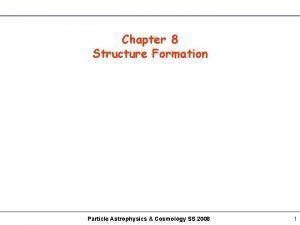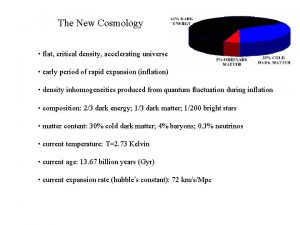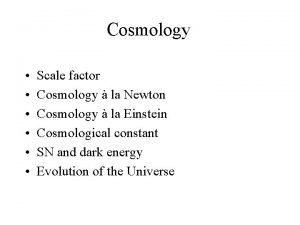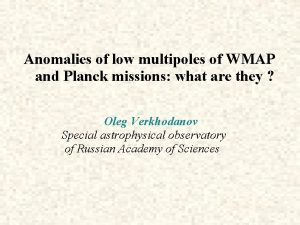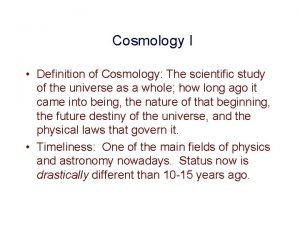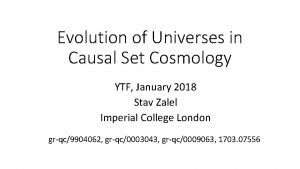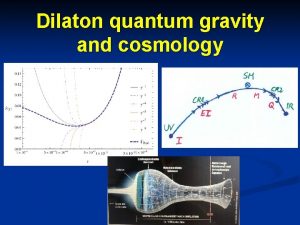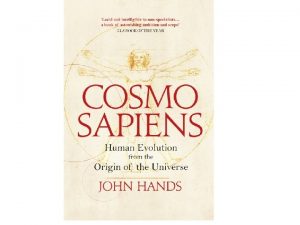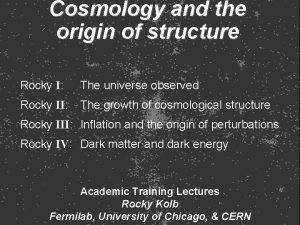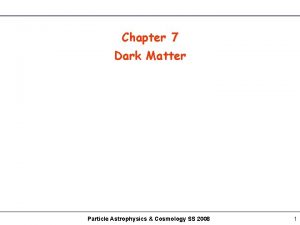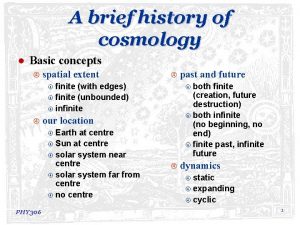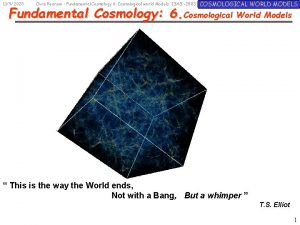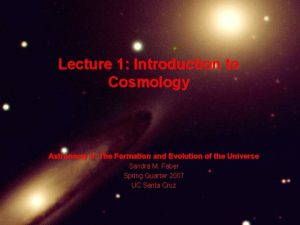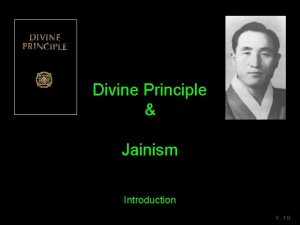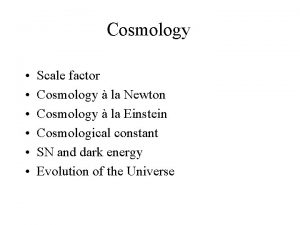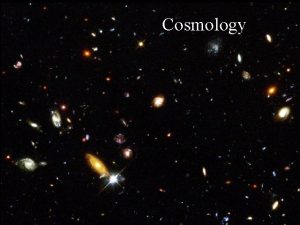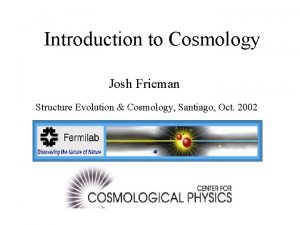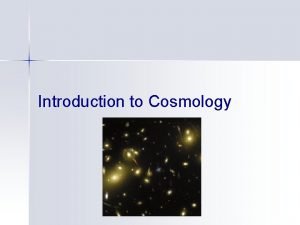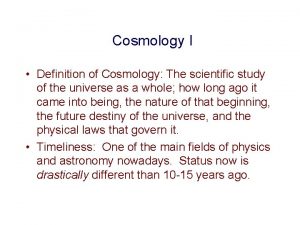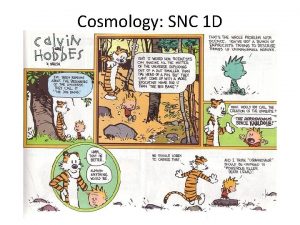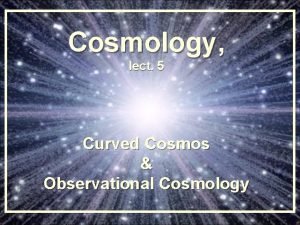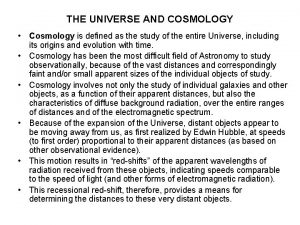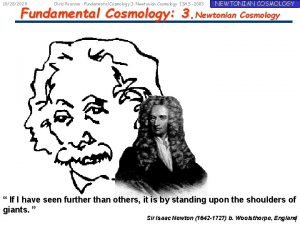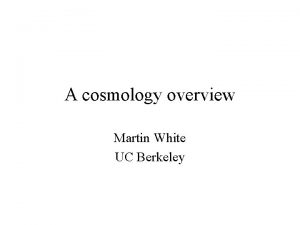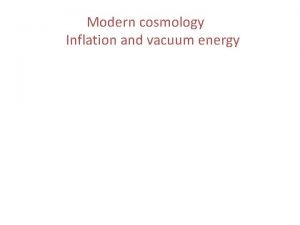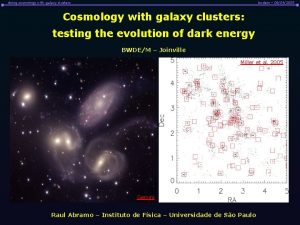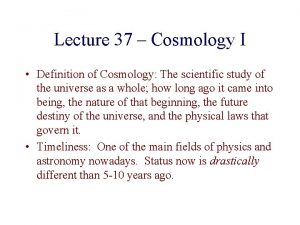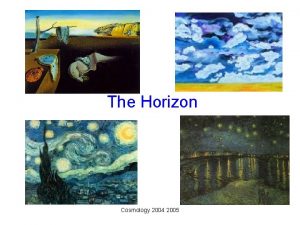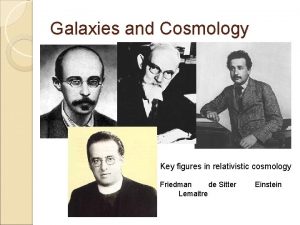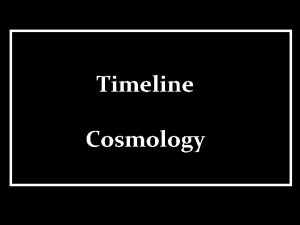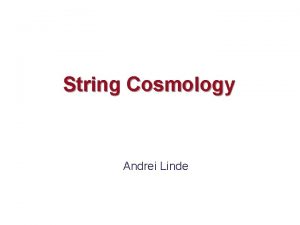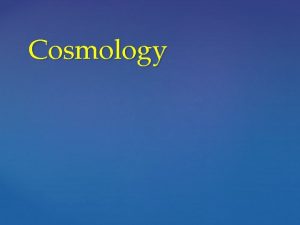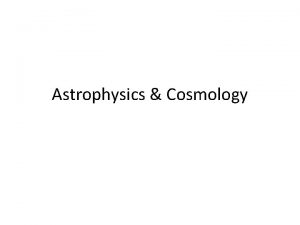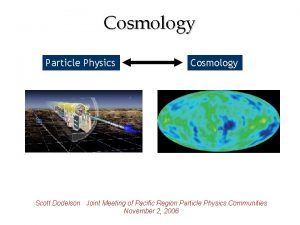Unit 8 Cosmology Cosmology Study of the structure































- Slides: 31

Unit 8 Cosmology

Cosmology Study of the structure and evolution of the entire universe

• The frontier of astronomy • More questions than answers • Origin, history, fate, age

• No special place in the universe • No center or edge

Hubble’s Law The space-time volume of the observable universe is expanding (from a smaller past to a larger future)

• All objects observed in deep space have a doppler shift observable relative velocity to Earth, and to each other • The velocity of galaxies receding from the Earth is proportional to their distance from the Earth and all other interstellar bodies.

Doppler Effect • http: //www. explorelearning. com/index. cfm? method=c. Resource. dsp. Detail&Resource. ID=18

Expanding universe


Georges Lemaître

Big Bang Theory

History • Early 20 th century Einstein and almost all scientists thought. . . Universe is static, unchanging, not expanding then…

• Einstein's field equations: (General Relativistic version of Newton's Equations of Motion) • Cosmological constant: Universe is expanding!

• Hubble (1930's): Discovers galaxies are receding from us Measures the expansion

• Einstein claims cosmological constant was the biggest blunder of his life • But recent evidence indicates he might have been right after all

Big Bang Theory Assumptions: • homogeneous, isotropic Universe • no edge, no center • every part looks the same (on average)

• initial `singularity' (beginning) • expansion • evolution cooling, transformation of energy matter, formation of structure

• http: //imagine. gsfc. nasa. gov/Videos/news/ex panding_univ. mov

Galaxy Formation Galaxies form from the primordial density fluctuations that arise after the big bang and grow under inflation. These density fluctuations form filaments, and galaxies form in knots along the filaments.

• microwave background radiation remnant of a primordial explosion Penzias and Wilson (1964) Bell Labs (ATT), New Jersey

The 20 foot Horn-Reflector

• The expansion history of the Universe is determined by the combination of: – matter – density – curvature


• A universe with less than the critical density is “open”, it will expand forever

• A universe with more than the critical density is “closed”, it will eventually recollapse

• A universe with exactly the critical density is “flat”, will expand forever

Multiverse Theory • Hypothetical set of multiple possible universes (including the historical universe we consistently experience) • Together comprise the entirety of space, time, matter, and energy • Also the physical laws that describe them.

M-Theory • Extension of string theory in which 11 dimensions are identified

Theory of Everything • • Scientific Understanding of the Universe All Matter & Forces in the Universe Unified by String Theory 6 extra dimensions of String Theory are very small 1 x 10 -33 cm in length

Ed Witten • Simplest M theory model contain two 9 dimensional surfaces (9 -branes) separated by the new spatial direction—one of which contains our universe. • More complicated models can contain more 9 dimensional surfaces moving between the 2 fixed branes.

• M Theory implies the existence of a Multiverse that contains 10500 universes • Each universe is brought about by its own Big Bang/Inflation • Contain vastly differing physical laws. • Some universes may have carbon-based life forms • Others vastly different life forms. • Majority may not allow for any life forms whatsoever
 Cosmology
Cosmology Critical density cosmology
Critical density cosmology Scale factor cosmology
Scale factor cosmology Tomislav prokopec
Tomislav prokopec Definition of cosmology
Definition of cosmology Stav zalel
Stav zalel Crossover cosmology
Crossover cosmology Concordance model of cosmology
Concordance model of cosmology Cosmology
Cosmology Cosmology
Cosmology Newton cosmology
Newton cosmology Cosmology
Cosmology Intro to cosmology
Intro to cosmology Jain geography universe
Jain geography universe Unit 10, unit 10 review tests, unit 10 general test
Unit 10, unit 10 review tests, unit 10 general test Hình ảnh bộ gõ cơ thể búng tay
Hình ảnh bộ gõ cơ thể búng tay Bổ thể
Bổ thể Tỉ lệ cơ thể trẻ em
Tỉ lệ cơ thể trẻ em Gấu đi như thế nào
Gấu đi như thế nào Chụp phim tư thế worms-breton
Chụp phim tư thế worms-breton Hát lên người ơi alleluia
Hát lên người ơi alleluia Các môn thể thao bắt đầu bằng tiếng đua
Các môn thể thao bắt đầu bằng tiếng đua Thế nào là hệ số cao nhất
Thế nào là hệ số cao nhất Các châu lục và đại dương trên thế giới
Các châu lục và đại dương trên thế giới Công thức tính độ biến thiên đông lượng
Công thức tính độ biến thiên đông lượng Trời xanh đây là của chúng ta thể thơ
Trời xanh đây là của chúng ta thể thơ Cách giải mật thư tọa độ
Cách giải mật thư tọa độ 101012 bằng
101012 bằng độ dài liên kết
độ dài liên kết Các châu lục và đại dương trên thế giới
Các châu lục và đại dương trên thế giới Thơ thất ngôn tứ tuyệt đường luật
Thơ thất ngôn tứ tuyệt đường luật
